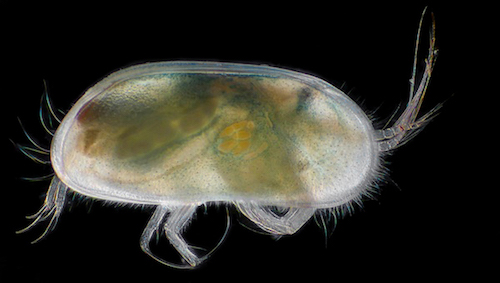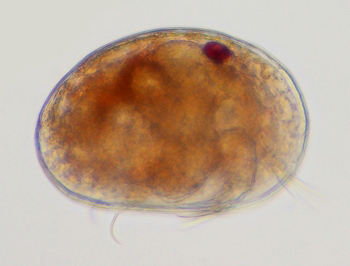
Ostracods - what are they?
Ostracods (Class Ostracoda) are a diverse group of small aquatic crustaceans, usually around 0.3 to 5 mm in length. Their most distinctive feature is their calcitic carapace; a hard, bivalved, hinged shell that can entirely cover and protect the non-mineralised body parts and appendages. Many ostracods have smooth rounded shells, hence their common name, seed-shrimps, while others are ornamented with pits, striations, spines, ridges, flanges etc.
More about the ostracod carapace...

A right side view of the ostracod Herpetocypris chevreuxi, a common freshwater species. The carapace, hinged along the top, is open and the appendages are extended through the gap. The ostracod can withdraw all of its appendages inside and close the carapace for protection. This species is about 1.9 mm long.
Inside the carapace ostracods have a complex body consisting of typically eight pairs of appendages, which have a range of functions including swimming, sensory, crawling, feeding and mating. When the shell is open, the appendages are extended through the gap for locomotion, feeding and mating.

Scanning electron microscopy image of an ostracod with the right valve removed, revealing the appendages inside the shell.
More about ostracod appendages...
Most ostracods are small enough that they can respire by absorbing oxygen directly from the water through the cuticle of the body. The carapace can hinder water flow around the body, so to overcome this, ostracods have a large, feathery branchial plate on the maxillula (and sometimes smaller ones on the mandibles and thoracic appendages) that is rapidly moved to create a current of water through the valve opening. Some of the larger marine groups, however, respire with gills.Most ostracods have a single eye consisting of three fused cups, situated near the anterior end of the hinge, just above the base of the antennules, but in some groups this is differentiated into two distinct halves connected in the middle, producing a dumb-bell shape when viewed from above (e.g. in the Notodromatidae). Other groups have a pair of compound eyes situated laterally in addition to the single dorsal eye. In hypogean species (subterranean species), the eye can be reduced or absent.
Reproduction and development
Ostracods reproduce both sexually (most marine forms) or asexually (many freshwater forms). One group of ostracods, the Cypridoidea, reproduces using giant sperm, which can be longer than the male; the longest ostracod sperm on record is 11.7 mm in length, 3.6 times the length of the male. The sexual apparatus is complex in this group, and includes large muscular pumps, called Zenker organs, used to transfer the sperm to the female. Everything is paired, so the male has two Zenker organs, eight testes (four on each side) and two penises.
Asexual species are common in freshwater habitats, mostly of the family Cyprididae. Populations consist of only females, and they produce clones of themselves in a process called parthenogenesis.
Ostracods typically have eight juvenile stages and one adult stage, called instars. Ostracods show direct development, meaning that they don't metamorphose during development, and the earliest instars look somewhat like adults, albeit much smaller and with fewer appendages. The first free-living instar that hatches from the egg has the antennules, antennae and mandibles, and in some groups an incipient caudal ramus as well. As the ostracod moults, additional appendages are added, and the existing appendages become more developed.

The first instar of an ostracod. While it only has three pairs of appendages, it still has a bivalved carapace. The dark red spot is the single eye.
Where they live
Ostracods can be found in most aquatic environments, including the sea (from the depths through to the shores), rivers, lakes, ponds, rice fields, small pools and puddles, groundwaters, springs, and wet leaf litter. Some marine ostracod groups are planktonic, but most groups either live on or near the bottom, on submerged plants, or on sediments. They can also be found in sediments, living in the tiny spaces between sediment grains (interstitial), and a small number are neustonic, spending time up-side-down at the water surface. One group, the family Entocytheridea, is commensal with other crustaceans, mostly crayfish, living on the gills and appendages of their hosts.
Planktonic ostracods are capable swimmers, while other groups can swim to get from place to place, but spend most of their time on the sediment surface. Many can't swim however, and crawl to get around, using their antennae and thoracic limbs.
Diet and predators
Ostracods eat a wide variety of food, including organic detritus, algae, plant material, dead animals and sometimes live animals such as young snails, worms and larvae of other crustaceans. Ostracods use their antennae, mandibles, maxillulae and, in some groups, the fifth limbs to feed.
More about the ostracod food...
Ostracods themselves can be consumed by chance (e.g. by water birds foraging in sediments and water plants), or by animals actively seeking them. Predators include fish, water mites, dragonfly larvae, and backswimmers. More about the ostracod predators...

The mouth parts of an ostracod.
Fossil record
There are approximately 33 000 fossil and living species of ostracods so far described, but there are many more yet to be discovered. It is estimated that the total number of living species is between 10 000 and 15 000.
Because the calcified carapace readily fossilises, ostracod are the most abundantly preserved arthropod group in the fossil record. They first appeared in the Ordovician Period (485 to 443 million years ago), and colonised freshwater habitats in the Carboniferous Period (359 to 299 million years ago).
Classification
The classification of living ostracods is as follows:Kingdom Animalia
Phylum Arthropoda
Subphylum Crustacea
Class Ostracoda
| Subclass Podocopa | Order Podocopida | Suborder Cytherocopina | Superfamily Cytheroidea (27 families) |
| Superfamily Terrestricytheroidea (1 family) | |||
| Suborder Cypridocopina | Superfamily Macrocypridoidea (1 family) | ||
| Superfamily Pontocypridoidea (1 family) | |||
| Superfamily Cypridoidea (4 families) | |||
| Suborder Darwinulocopina | Superfamily Darwinuloidea (1 family) | ||
| Suborder Bairdiocopina | Superfamily Bairdioidea (3 families) | ||
| Suborder Sigilliocopina | Superfamily Sigillioidea (1 family) | ||
| Order Platycopida | Suborder Platycopina | Superfamily Cytherelloidea (1 family) | |
| Order Palaeocopida | Suborder Kirkbyocopina | Superfamily Puncioidea (1 genus) | |
| Subclass Myodocopa | Order Myodocopida | Suborder Myodocopina | Superfamily Cypridinoidea (1 family) |
| Superfamily Cylindroleberidoidea (1 family) | |||
| Superfamily Sarsielloidea (3 families) | |||
| Order Halocyprida | Suborder Halocypridina | Superfamily Thaumatocypridoidea (1 family) | |
| Superfamily Halocypridoidea (1 family) | |||
| Suborder Cladocopina | Superfamily Cladocopoidea (1 family) |
Studying Freshwater Ostracods - Essential Publications
Dissecting ostracods
For identification down to the species level it is usually necessary to dissect specimens. Dissecting something only about 1 mm in size might sound difficult, but with a bit of practice most people can master it. An excellent guide to dissecting ostracods can be downloaded for free.
Namiotko, T., Danielopol, D. L. & Baltanás, A. 2011. Soft body morphology, dissection and slide-preparation of Ostracoda: a primer. Joannea Geol. Paläont., 11, 327-343.
[PDF file, external link]
Identifying ostracods
The most useful single publication is Claude Meisch's book on freshwater ostracods from Western and Central Europe. Even if you are studying ostracods from areas outside of Europe, this is still a useful book, because many genera and species found in Europe are also found elsewhere. Each species covered includes diagrams of the carapaces and appendages.
Meisch, C. 2000 Freshwater Ostracoda of Western and Central Europe. In: Schwoerbel, J., Zwick, P. (Eds.), Süsswasserfauna von Mitteleuropa 8/3. Spektrum Akademischer Verlag, Heidelberg, Berlin, 522 pp. [External link]
Another useful publication is a checklist of all extant non-marine, free-living ostracods, which can be downloaded for free from the European Journal of Taxonomy.
Meisch, C., Smith, R. J. & Martens, K. 2019. A subjective global checklist of the extant non-marine Ostracoda (Crustacea). European Journal of Taxonomy, 492, 1-135. [External link]
Covering 181 species, the Atlas of Quaternary and Recent Ostracods of Middle Germany by Roland Fuhrmann is another book that every ostracod researcher should have. It figures only the carapaces and valves, but each species is covered with high quality scanning electron microscopy photographs. The text is in German. Furhmann, R. 2012. Atlas quartärer und rezenter Ostracoden Mitteldeutshlands. Altenburger Naturwissenschaftliche Forschungen, Heft 15. [External link]
There are, of course, thousands of other publications on ostracods, most of which can only be obtained from academic libraries, by subscriptions to scientific journals, or from the original authors. However, some of the older publications on ostracods can be downloaded for free from the Biodiversity Heritage Library [External link]